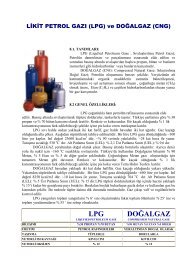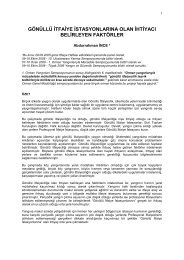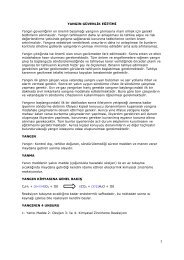buradan - Yangın
buradan - Yangın
buradan - Yangın
You also want an ePaper? Increase the reach of your titles
YUMPU automatically turns print PDFs into web optimized ePapers that Google loves.
The BMS will slow the spread of fire as the entire air handling<br />
system has been shut down. That’s good news for preventing<br />
the spread of fire, but bad news for business, particularly if the<br />
computer room that houses all the customer records is now<br />
starting to overheat because the feed for the air conditioning has<br />
been cut off.<br />
Once the all-clear has been given to go back into the building, the<br />
employees may find that they have no work to go back to. The<br />
servers have shut down (if they are lucky) or they have overheated<br />
and critical business information is inaccessible whilst the IT<br />
manager implements the disaster recovery procedure to bring<br />
online yesterday’s back-ups. This is not a good situation for today’s<br />
customers - all for the sake of intelligent control.<br />
1.2. The smart option<br />
Here the same scenario<br />
is assessed, but using the<br />
intelligent approach. The<br />
fire alarm has operated,<br />
and this time it is possible<br />
to tell if it is a false alarm.<br />
In the event of a fire alarm<br />
activation, the same<br />
CCTV cameras used<br />
to protect people and<br />
property against theft and<br />
vandalism can now be automatically coordinated to check for the<br />
presence of a fire. Now the Brigade only needs to attend when<br />
the operator sees the tell-tale signs on their monitor – a confirmed<br />
response. In addition, the CCTV recording system will archive the<br />
images taken from the cameras closest to the fire in the minutes<br />
before the alarm, providing important information on the cause of<br />
the blaze (or the false alarm).<br />
The access control system responds to the alarm, allowing quick<br />
and easy egress from the building, whilst also preventing access<br />
by those without appropriate access rights to important areas<br />
unaffected by the fire. As the fire spreads, the access control<br />
system adjusts in accordance with the needs of the occupants and<br />
the applications within the building.<br />
In addition to the security benefits that truly intelligent integration<br />
brings, the access control system also provides a muster report of<br />
personnel locations, based on where they were last logged inside<br />
or outside the building. This provides an accurate picture for the<br />
emergency services to work with in a rescue scenario and increases<br />
the chances of a successful resolution whilst also reducing the risk<br />
posed to rescue staff.<br />
The BMS will control air handling units, switching them on or off<br />
in conjunction with the spread of fire and intelligently selecting<br />
the areas of the building to isolate whilst other systems continue<br />
to function normally. This avoids unnecessary loss of business<br />
without sacrificing speed of response. It’s not just the fire system<br />
that senses the effects of heat. The BMS could be used to report<br />
temperature changes in the areas identified by the fire alarm,<br />
helping to support, albeit with secondary information, confirmation<br />
of a genuine fire condition. This illustrates how a little more<br />
intelligence goes a very long way.<br />
BİLDİRİLER KİTABI TÜYAK<br />
PROCEEDINGS BOOK 2009<br />
1.3. how Is Intelligent Integration Achieved?<br />
Systems can be integrated by using a hardware or software<br />
solution. The hardware solution is often very limited in the amount<br />
of control and information that can be shared between systems,<br />
especially those that are already established in a building.<br />
It is similar to getting something to work on a PC. Hardware<br />
solutions are designed to meet certain defacto standards and if<br />
the building user’s system is in some way different, it won’t do all<br />
that is required. A significant amount of time might be spent liaising<br />
with different manufacturers when something does not work.<br />
Meanwhile, the building is not fully provided for.<br />
The software solution on the other hand is very flexible, particularly<br />
if used with the manufacturer’s entire building solution. This<br />
approach can grow with the building, making use of new software<br />
releases and will readily share information between systems for<br />
display and control from one common platform.<br />
Systems can be added as and when required and the software<br />
solution is not reliant upon components being in place from the<br />
beginning. Specific modules can be introduced and engineered<br />
to take care of their respective application. A life safety module,<br />
for example, will provide the interface between the fire system and<br />
the integration package, providing visual representation of cause<br />
and effect.<br />
In this way, an entire enterprise or building can be fully integrated<br />
over a period of time, reducing the impact of cost whilst maximising<br />
the effect on reducing risk. If all of the system components come<br />
from one manufacturer, the likelihood of a compatibility issue is<br />
reduced to zero, as the manufacturer takes total responsibility for<br />
the entire system.<br />
With the emphasis across Europe on risk management and control,<br />
an intelligent approach can really help a user to manage their risks<br />
and to comply with local requirements.<br />
3. Conclusion<br />
In answer to the question, is integration a buzz word, it’s certainly<br />
a much mis-used term within the industry. However, a smart, truly<br />
intelligent approach to integration offers so much more. It not only<br />
makes sense with regard to safety and security, but can safeguard<br />
TÜYAK 2009<br />
3





